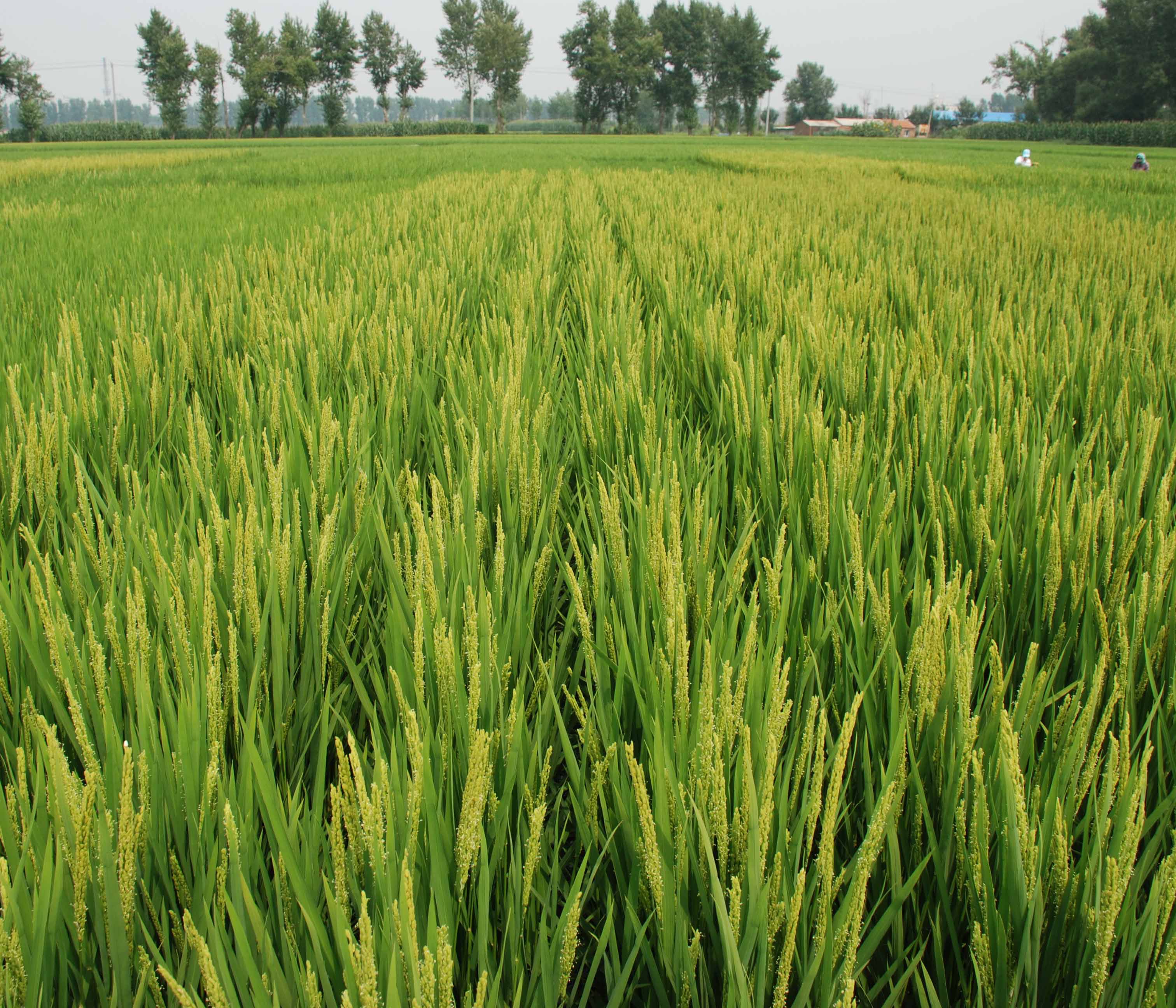

Changes in Sink-source Variation Characteristics of Different Rice Varieties
? These authors contributed equally to this paper
Received date: 2014-12-08
Accepted date: 2015-03-19
Online published: 2015-09-06
We aimed to understand the relationship between sink, source and sink-source in Oryza sativa cultivars released in different years. With 33 rice varieties bred for materials, sink, source and sink-source were studied from 1958 to 2005 in Jilin Province. Rice genetic-improvement sink and source traits improved in Jilin Province in 47 years. For sink, panicle weight and number of seeds were positively correlated with year of release, increased by 62.93% and 37.65%, respectively, and 1.34% and 0.80% on average, respectively. For source, leaf area per plant, flag leaf photosynthetic capacity and net photosynthetic rate (Pn) were positively correlated with year of release, increased by 13.75%, 24.80% and 12.60%, with the annual growth rate 0.29%, 0.53% and 0.27% in last 47 years. Different rice varieties ear weight/plant photosynthetic capacity and grains/plant photosynthetic capacity did not differ. However, panicle weight/leaf area and grains/leaf area showed a significant positive correlation with breeding age (correlation coefficients 0.441 0, P<0.05, and 0.401 7, P<0.05). Panicle weight/Pn and grains/Pn showed a significant positive correlation with breeding age (correlation coefficients 0.509 3, P<0.01, and 0.483 2, P<0.01). Rice production can be increased as a result of sink-source interaction in Jilin Province, but improving photosynthetic capacity per unit leaf area growth lags far behind other sink-source traits. Improving the leaf Pn, leaf photosynthetic capacity should improve with the new high-yielding rice varieties breeding goals.

Kezhang Xu , Zhanyu Chen , Chunsheng Wu , Jingjing Cui , Zhihai Wu , Zhian Zhang , Jingjiao Shi . Changes in Sink-source Variation Characteristics of Different Rice Varieties[J]. Chinese Bulletin of Botany, 2015 , 50(6) : 699 -705 . DOI: 10.11983/CBB14206
| [1] | 曹树青, 翟虎渠, 张荣铣, 杨图南, 匡廷云 (2001). 水稻种质资源光合速率及光合功能期的研究. 中国水稻科学 15, 29-34. |
| [2] | 陈温福, 徐正进, 张龙步 (2005). 北方粳型超级稻育种的理论与方法. 沈阳农业大学学报 36, 3-8. |
| [3] | 程式华, 曹立勇, 陈深广, 朱德峰, 王熹, 闵绍楷, 翟虎渠 (2005). 后期功能型超级杂交稻的概念及生物学意义. 中国水稻科学 19, 280-284. |
| [4] | 大野义一 (1979). 籼稻光合效率的品种间差异和干物质生产. 北京: 中国农业出版社. pp. 11-108. |
| [5] | 段俊, 梁承邺, 黄毓文, 陈宝源, 罗廉源 (1996). 不同类型水稻品种(组合)籽粒灌浆特性及库源关系的比较研究. 中国农业科学 29(3), 66-73. |
| [6] | 黄育民, 陈启锋, 李义珍 (1998). 我国水稻品种改良过程源库特征的变化. 福建农业大学学报 27, 271-278. |
| [7] | 黄育民, 李义珍, 庄占龙, 郑景生, 余瑞远 (1996). 杂交稻高产群体干物质积累运转I. 干物质的积累运转. 福建省农科院学报 11(2), 7-11. |
| [8] | 姜楠, 邸玉婷, 徐克章, 赵国臣, 凌凤楼, 武志海, 张治安 (2011). 吉林省不同年代育成水稻品种上三叶光合特性的变化. 作物学报 37, 703-710. |
| [9] | 凌启鸿 (1995).水稻群体质量理论与实践. 北京: 中国农业出版社. pp. 34-44. |
| [10] | 刘宛, 徐正进, 陈温福, 李金泉, 李磊鑫, 张龙步 (2001). 不同氮素水平对直立穗型水稻品种群体光合特性的影响. 沈阳农业大学学报 32, 8-12. |
| [11] | 马文波, 马均, 明东风, 许凤英, 严志彬, 孙晓辉 (2003). 不同穗重型水稻品种剑叶光合特性的研究. 作物学报 29, 236-240. |
| [12] | 盛大海, 刘元英, 李广宇 (2009). 水稻源库关系研究进展与应用. 东北农业大学学报 40(5), 117-122. |
| [13] | 苏祖芳, 张亚洁, 张娟, 张海泉, 姚志发, 沈富荣, 姚友权, 李本良 (1995).基蘖肥与穗粒肥配比对水稻产量形成和群体质量的影响. 江苏农学院学报 16(3), 21-30. |
| [14] | 屠乃美, 官春云 (1999). 水稻幼穗分化期间减源对源库关系的影响. 湖南农业大学学报 25, 430-436. |
| [15] | 杨惠杰, 李义珍, 黄育民, 郑景生, 姜照伟, 林文 (1999). 超高产水稻的产量构成和库源结构. 福建农业学报 14, 1-5. |
| [16] | 杨建昌, 苏宝林, 王志琴, 郎有忠, 朱庆森 (1998). 亚种间杂交稻籽粒灌浆特性及其生理的研究. 中国农业科学 31, 7-14. |
| [17] | 殷宏章, 沈允钢, 陈因, 余志新, 李娉嫦 (1956). 水稻开花后干物质的积累和运输. 植物学报 5, 177-194. |
| [18] | 赵国臣, 郭唏明 (2000). 21世纪吉林省水稻栽培研究展望. 延边大学农学学报 22, 63-65. |
| [19] | 赵全志, 高尔明, 黄丕生, 凌启鸿, 孙淑萍, 焦三军 (1999). 源库质量与作物超高产栽培及育种. 河南农业大学学报 33, 226-230. |
| [20] | 赵全志, 黄丕生, 凌启鸿, 高尔明, 董家胜 (2000). 水稻颖花伤流量与群体质量的关系. 南京农业大学学报 23(3), 9-12. |
| [21] | Sasaki H, Ishii R (1992). Cultivar differences in leaf photosynthesis of rice bred in Japan.Photosynth Res 32, 139-146. |
| [22] | Wilson J (1971). Photosynthesis and energy conversion. In: Warring PF, Cooper JP, eds. Potential Crop Production. Exeter: Educational Books. pp. 43-75. |
| [23] | Yang JC, Zhang WH, Wang ZQ, Liu LJ, Zhu QS (2002). Source-sink characteristics and the translocation of assimilates in new plant type and intersubspecific hybrid rice.Agric Sci China 1, 155-162. |
/
| 〈 |
|
〉 |